开机流程 模块管理 Loader
主机系统开机流程

boot loader 主要功能



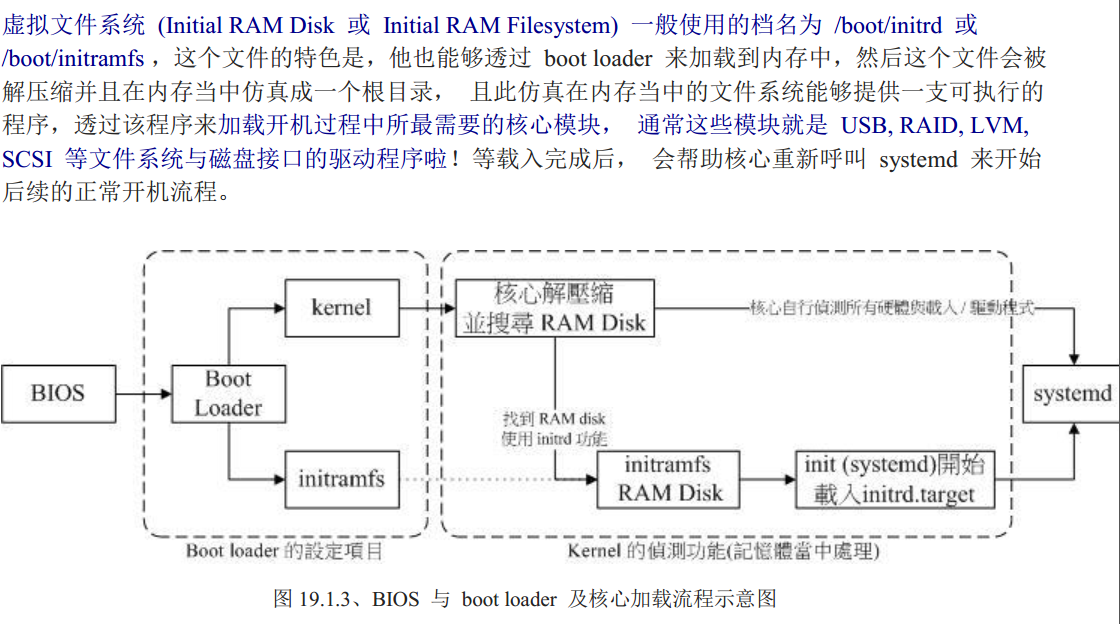



显示核心模块加载信息

查询模块信息
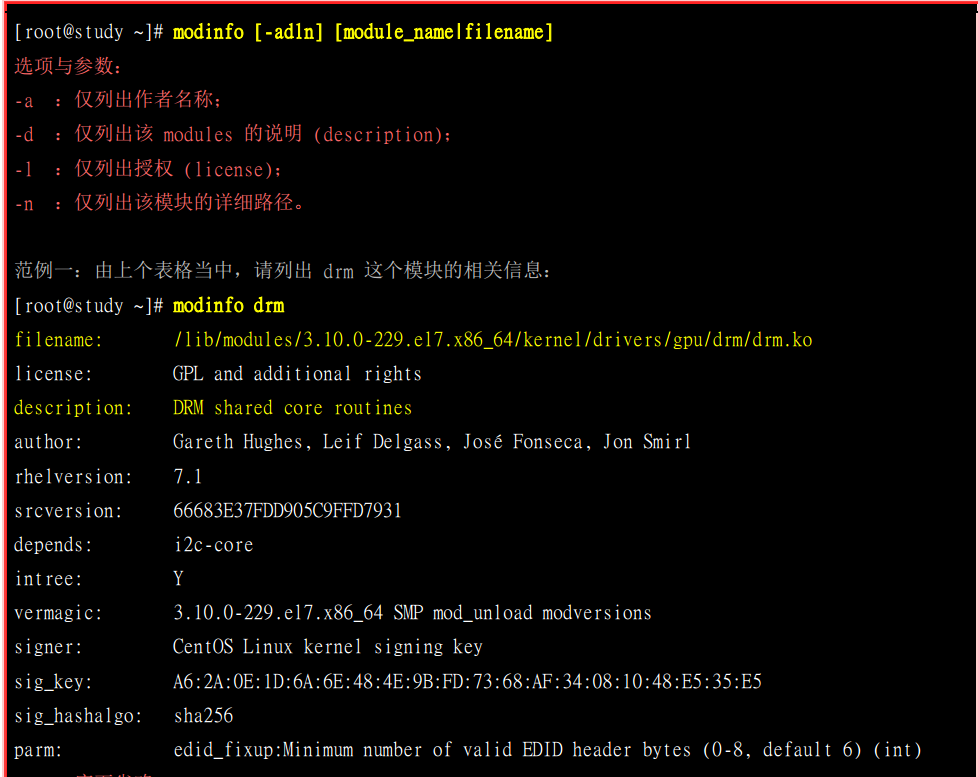
核心模块的加载与移除


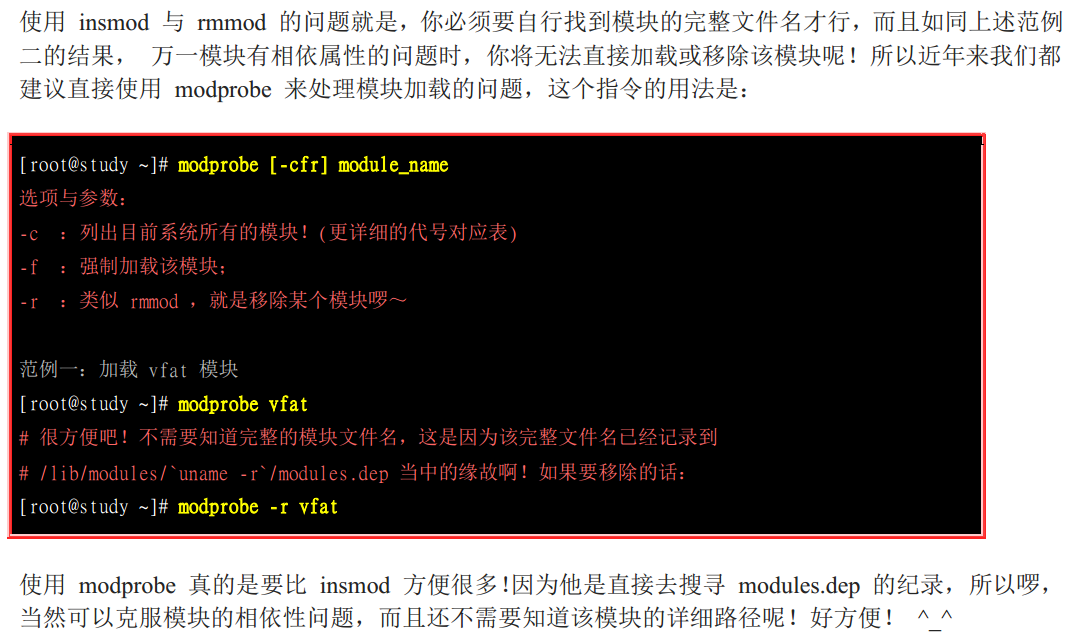
boot loader 的两个 stage



grup2配置文件 /boot/grub2/grub.cfg

grub2识别磁盘
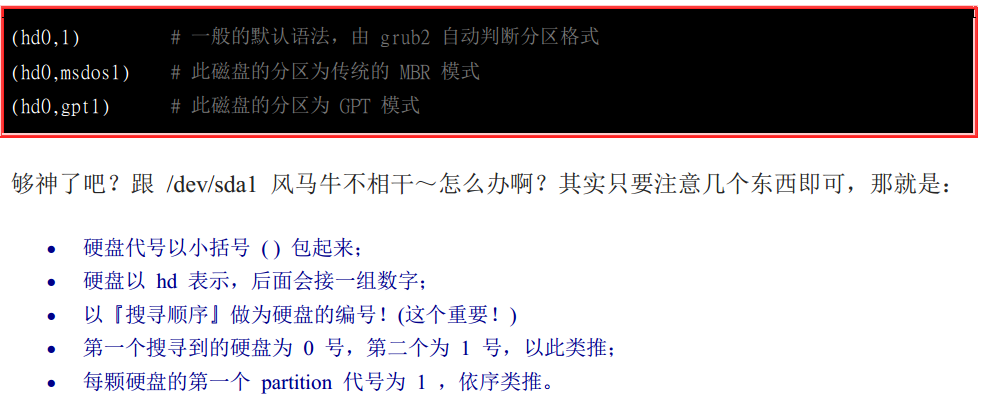


grub2 配置文件 /etc/default/grub 和 /etc/grub.d



[root@localhost grub.d]# cat /boot/grub2/grub.cfg
#
# DO NOT EDIT THIS FILE
#
# It is automatically generated by grub2-mkconfig using templates
# from /etc/grub.d and settings from /etc/default/grub
# ### BEGIN /etc/grub.d/00_header ###
set pager= if [ -s $prefix/grubenv ]; then
load_env
fi
if [ "${next_entry}" ] ; then
set default="${next_entry}"
set next_entry=
save_env next_entry
set boot_once=true
else
set default="${saved_entry}"
fi if [ x"${feature_menuentry_id}" = xy ]; then
menuentry_id_option="--id"
else
menuentry_id_option=""
fi export menuentry_id_option if [ "${prev_saved_entry}" ]; then
set saved_entry="${prev_saved_entry}"
save_env saved_entry
set prev_saved_entry=
save_env prev_saved_entry
set boot_once=true
fi function savedefault {
if [ -z "${boot_once}" ]; then
saved_entry="${chosen}"
save_env saved_entry
fi
} function load_video {
if [ x$feature_all_video_module = xy ]; then
insmod all_video
else
insmod efi_gop
insmod efi_uga
insmod ieee1275_fb
insmod vbe
insmod vga
insmod video_bochs
insmod video_cirrus
fi
} terminal_output console
if [ x$feature_timeout_style = xy ] ; then
set timeout_style=menu
set timeout=
# Fallback normal timeout code in case the timeout_style feature is
# unavailable.
else
set timeout=
fi
### END /etc/grub.d/00_header ### ### BEGIN /etc/grub.d/00_tuned ###
set tuned_params=""
set tuned_initrd=""
### END /etc/grub.d/00_tuned ### ### BEGIN /etc/grub.d/01_users ###
if [ -f ${prefix}/user.cfg ]; then
source ${prefix}/user.cfg
if [ -n "${GRUB2_PASSWORD}" ]; then
set superusers="root"
export superusers
password_pbkdf2 root ${GRUB2_PASSWORD}
fi
fi
# END /etc/grub.d/01_users ###
▽
### BEGIN /etc/grub.d/10_linux ###
menuentry 'CentOS Linux (3.10.0-957.el7.x86_64) 7 (Core)' --class centos --class gnu-linux --class gnu --class os --unrestricted $menuentry_id_option 'gnulinux-3.10.0-957.el7.x86_64-advanced-ccdda529-f59c-4990-9165-b6d1cd522034' {
load_video
set gfxpayload=keep
insmod gzio
insmod part_msdos
insmod xfs
set root='hd0,msdos1'
if [ x$feature_platform_search_hint = xy ]; then
search --no-floppy --fs-uuid --set=root --hint-bios=hd0,msdos1 --hint-efi=hd0,msdos1 --hint-baremetal=ahci0,msdos1 --hint='hd0,msdos1' ba80a371-e434-431e--df4b2827efad
else
search --no-floppy --fs-uuid --set=root ba80a371-e434-431e--df4b2827efad
fi
linux16 /vmlinuz-3.10.-.el7.x86_64 root=/dev/mapper/centos-root ro crashkernel=auto rd.lvm.lv=centos/root rd.lvm.lv=centos/swap rhgb quiet LANG=zh_CN.UTF-
initrd16 /initramfs-3.10.-.el7.x86_64.img
}
menuentry 'CentOS Linux (0-rescue-f7819fbfbe0b4074b5dfebfab540afcb) 7 (Core)' --class centos --class gnu-linux --class gnu --class os --unrestricted $menuentry_id_option 'gnulinux-0-rescue-f7819fbfbe0b4074b5dfebfab540afcb-advanced-ccdda529-f59c-4990-9165-b6d1cd522034' {
load_video
insmod gzio
insmod part_msdos
insmod xfs
set root='hd0,msdos1'
if [ x$feature_platform_search_hint = xy ]; then
search --no-floppy --fs-uuid --set=root --hint-bios=hd0,msdos1 --hint-efi=hd0,msdos1 --hint-baremetal=ahci0,msdos1 --hint='hd0,msdos1' ba80a371-e434-431e--df4b2827efad
else
search --no-floppy --fs-uuid --set=root ba80a371-e434-431e--df4b2827efad
fi
linux16 /vmlinuz--rescue-f7819fbfbe0b4074b5dfebfab540afcb root=/dev/mapper/centos-root ro crashkernel=auto rd.lvm.lv=centos/root rd.lvm.lv=centos/swap rhgb quiet
initrd16 /initramfs--rescue-f7819fbfbe0b4074b5dfebfab540afcb.img
} ### END /etc/grub.d/10_linux ### ### BEGIN /etc/grub.d/20_linux_xen ###
### END /etc/grub.d/20_linux_xen ### ### BEGIN /etc/grub.d/20_ppc_terminfo ###
### END /etc/grub.d/20_ppc_terminfo ### ### BEGIN /etc/grub.d/30_os-prober ###
### END /etc/grub.d/30_os-prober ### ### BEGIN /etc/grub.d/40_custom ###
# This file provides an easy way to add custom menu entries. Simply type the
# menu entries you want to add after this comment. Be careful not to change
# the 'exec tail' line above.
### END /etc/grub.d/40_custom ### ### BEGIN /etc/grub.d/41_custom ###
if [ -f ${config_directory}/custom.cfg ]; then
source ${config_directory}/custom.cfg
elif [ -z "${config_directory}" -a -f $prefix/custom.cfg ]; then
source $prefix/custom.cfg;
fi
### END /etc/grub.d/41_custom ###
[root@localhost grub.d]# vim /etc/grub.d/40_custom
#!/bin/sh
exec tail -n + $
# This file provides an easy way to add custom menu entries. Simply type the
# menu entries you want to add after this comment. Be careful not to change
# the 'exec tail' line above.
menuentry 'My graphical Centos' --class centos --class gnu-linux --class gnu --class os --unrestricted --id 'mygraphical' $menuentry_id_option 'gnulinux-3.10.0-957.el7.x86_64-advanced-ccdda529-f59c-4990-9165-b6d1cd522034' {
load_video
set gfxpayload=keep
insmod gzio
insmod part_msdos
insmod xfs
set root='hd0,msdos1'
if [ x$feature_platform_search_hint = xy ]; then
search --no-floppy --fs-uuid --set=root --hint-bios=hd0,msdos1 --hint-efi=hd0,msdos1 --hint-baremetal=ahci0,msdos1 --hint='hd0,msdos1' ba80a371-e434-431e--df4b2827efad
else
search --no-floppy --fs-uuid --set=root ba80a371-e434-431e--df4b2827efad
fi
linux16 /vmlinuz-3.10.-.el7.x86_64 root=/dev/mapper/centos-root ro crashkernel=auto rd.lvm.lv=centos/root rd.lvm.lv=centos/swap rhgb quiet LANG=zh_CN.UTF- systemd.unit=graphical.target
initrd16 /initramfs-3.10.-.el7.x86_64.img
}
~
"40_custom" 20L, 1185C 已写入
[root@localhost grub.d]# grub2-mkconfig -o /boot/grub2/grub.cfg
Generating grub configuration file ...
Found linux image: /boot/vmlinuz-3.10.-.el7.x86_64
Found initrd image: /boot/initramfs-3.10.-.el7.x86_64.img
Found linux image: /boot/vmlinuz--rescue-f7819fbfbe0b4074b5dfebfab540afcb
Found initrd image: /boot/initramfs--rescue-f7819fbfbe0b4074b5dfebfab540afcb.img
done
[root@localhost grub.d]# reboot

选择之后就会直接进入我们的图形界面
设置默认开机画面为字符
[root@localhost /]# sudo systemctl set-default multi-user.target
Removed symlink /etc/systemd/system/default.target.
Created symlink from /etc/systemd/system/default.target to /usr/lib/systemd/system/multi-user.target.
以前我们设置的默认开机方式是图形界面,经过上面设置之后,默认设置就变成了命令行模式。
但是当我们选择第三项,我们自己的设置的时候,他还是会进入图形界面。有点意思。
透过chainloader 的方式移交lader 控制权
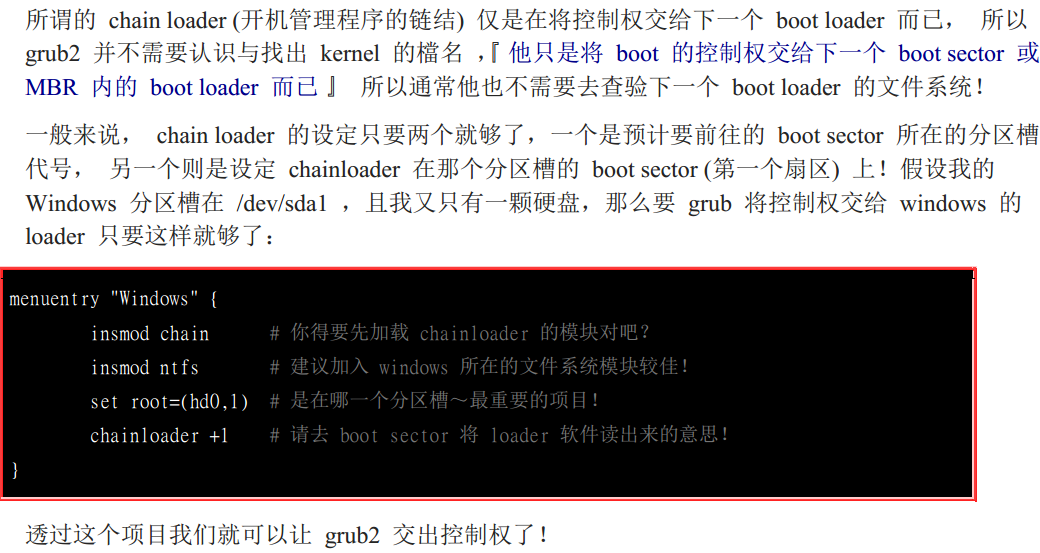
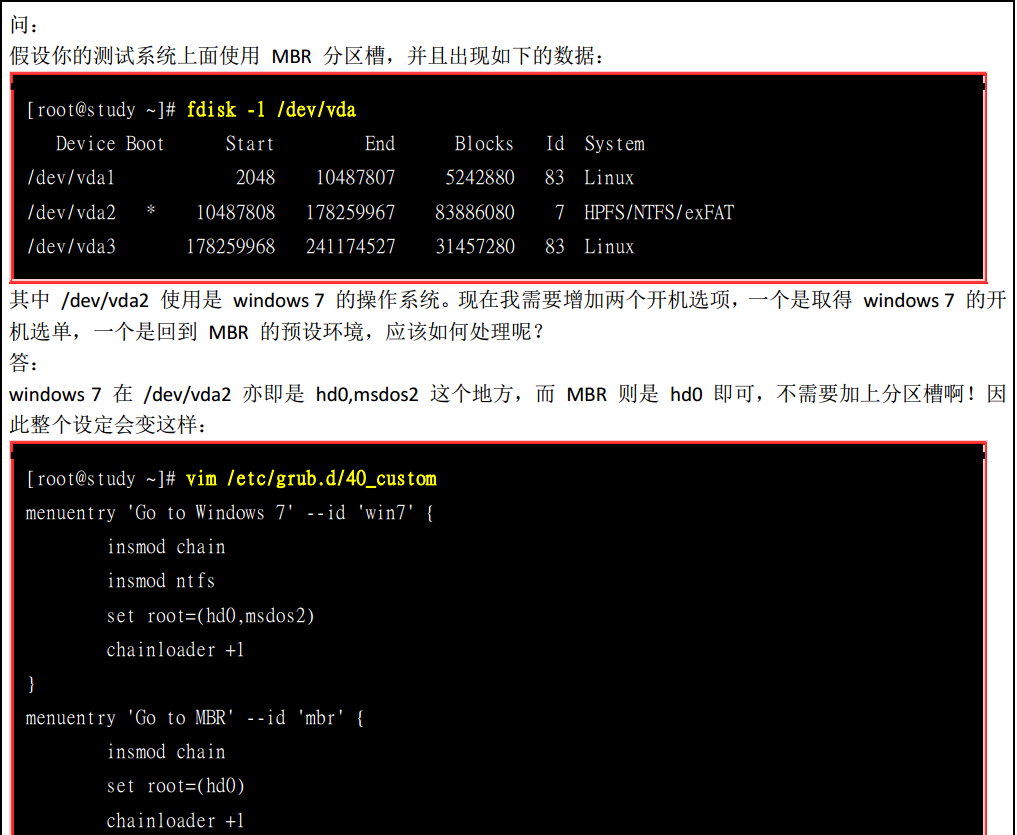

上面主要介绍的做双系统的相关知识(我觉得),还是需要实践,看是看不会的。。。。下面有时间会找台机器做测试。来做双系统试一下

开机流程 模块管理 Loader的更多相关文章
- Linux入门进阶第六天——登录文件、开机与模块管理
一.登录文件概述 1.什么是登录文件 简单的说,就是记录系统活动信息的几个文件, 例如:何时.何地(来源 IP).何人 (什么服务名称).做了什么动作 (讯息登录啰). 换句话说就是:记录系统在什么时 ...
- liunx 开机流程与模块管理
系统开机的经过可以汇整成底下的流程的: 加载 BIOS 的硬件信息与进行自我测试,并依据设定取得第一个可开机的装置: 读取并执行第一个开机装置内 MBR 的 boot Loader (亦即是 grub ...
- 第五部分 linux系统管理员 开机流程 模组管理 与loader
第五部分 linux系统管理员 开机流程 模组管理 与loader 开机流程分析 cmos保存电脑硬件的参数 bios 基本的输入输出系统 读取硬件的软件 MBR master bo ...
- Linux之RHEL6的开机流程分析
开机——很多人觉得很简单的事情,只要按下电源开关,然后系统就会自然启动,没有什么需要学习的.其实不然,如果系统没有什么问题,可以正常登陆的时候,当然开机很简单.但更多的时候,我们需要知道当机子不能正常 ...
- Linux学习-Linux 的开机流程分析
开机流程一览 系统开机的经过可以汇整成底下的流程的: 加载 BIOS 的硬件信息与进行自我测试,并依据设定取得第一个可开机的装置; 读取并执行第一个开机装置内 MBR 的 boot Loader (亦 ...
- IA-32/centos7开机流程
开机后系统首先在实地址模式下工作(只有1MB的寻址空间) 开机过程中,需要先准备在实模式下的中断向量表和中断服务程序.通常,由固化在主板上一块ROM芯片中的BIOS程序完成 加载BIOS的硬件信息,B ...
- linux系统的开机流程
开机流程: 1)BIOS:开机主动运行的韧体.会认识第一个可开机设备. 2)MBR:第一个可开机设备的第一个扇区内的主引导分区块.当中包括引导载入程序. 3)引导载入程序:一支可读取内核文件来运行的软 ...
- CentOS开机流程详解
一个执着于技术的公众号 开机流程 BIOS: (Basic Input Output System)基本输入输出系统,它是一组固化到计算机内主板上一个ROM芯片上的程序,保存着计算机最重要的基本输入输 ...
- 开机流程与主引导分区(MBR)——鸟哥私房菜
在前篇随笔中,已经谈到了CMOS与BIOS,CMOS是记录各项硬件参数(包括系统时间.设备的I/O地址.CPU的电压和频率等)且嵌入到主板上面的存储器,BIOS是一个写入到主板上的韧体(韧体是写入到硬 ...
随机推荐
- Android关于界面一定时间无操作自动跳转到指定界面的实现
主要用到的功能,自定义一个定时器CountTimer继承CountDownTimer. public class CountTimer extends CountDownTimer { private ...
- elasticsearch Mapping 定义索引
Mapping is the process of defining how a document should be mapped to the Search Engine, including i ...
- oracle时间问题 与case then
思路一 --select * from nls_session_parameters where parameter='NLS_DATE_LANGUAGE'; -- 修改会话的默认日期格式 ALTER ...
- 关于python接口测试connect error
接口测试里如果报错出现 socket.gaierror: [Errno 8] nodename nor servname provided, or not known 或者 urllib3.excep ...
- The user specified as a definer ('root'@'%') does not exist解决
转自:https://www.cnblogs.com/hanxue53/p/5850263.html 解决方法: 2.进入mysql的安装路径之前,要确保你的mysql服务是开启的: 在DOS命令窗口 ...
- Delphi 访问https /SSL、OpenSSL
访问 Web 网站,最简单用法直接使用 TIdHTTP 控件: 例如:AA := IdHTTP1.Get('www.baidu.com.'); 访问 https 的网站,需要 SSL 库. 在 Win ...
- POJ 2808 校门外的树(线段树入门)
题目描述 某校大门外长度为L的马路上有一排树,每两棵相邻的树之间的间隔都是1米.我们可以把马路看成一个数轴,马路的一端在数轴0的位置,另一端在L的位置:数轴上的每个整数点,即0,1,2,……,L,都种 ...
- spring+websocket的整合实例--可使用
spring+websocket的整合实例----借鉴如下链接--此贴用于笔记 https://blog.csdn.net/qq_35515521/article/details/78610847
- JavaScript 工作原理之十一-渲染引擎及性能优化小技巧
原文请查阅这里,略有删减,本文采用知识共享署名 4.0 国际许可协议共享,BY Troland. 本系列持续更新中,Github 地址请查阅这里. 这是 JavaScript 工作原理的第十一章. 迄 ...
- (转)Spring Boot干货系列:(七)默认日志logback配置解析
转:http://tengj.top/2017/04/05/springboot7/ 前言 今天来介绍下Spring Boot如何配置日志logback,我刚学习的时候,是带着下面几个问题来查资料的, ...
